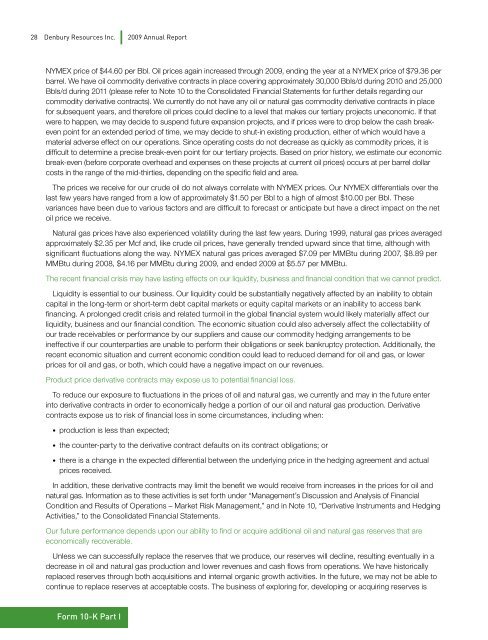Interactive 2009 Annual Report (PDF 7.56 MB) - Denbury Resources ...
Interactive 2009 Annual Report (PDF 7.56 MB) - Denbury Resources ...
Interactive 2009 Annual Report (PDF 7.56 MB) - Denbury Resources ...
- No tags were found...
You also want an ePaper? Increase the reach of your titles
YUMPU automatically turns print PDFs into web optimized ePapers that Google loves.
28 <strong>Denbury</strong> <strong>Resources</strong> Inc. <strong>2009</strong> <strong>Annual</strong> <strong>Report</strong>NYMEX price of $44.60 per Bbl. Oil prices again increased through <strong>2009</strong>, ending the year at a NYMEX price of $79.36 perbarrel. We have oil commodity derivative contracts in place covering approximately 30,000 Bbls/d during 2010 and 25,000Bbls/d during 2011 (please refer to Note 10 to the Consolidated Financial Statements for further details regarding ourcommodity derivative contracts). We currently do not have any oil or natural gas commodity derivative contracts in placefor subsequent years, and therefore oil prices could decline to a level that makes our tertiary projects uneconomic. If thatwere to happen, we may decide to suspend future expansion projects, and if prices were to drop below the cash breakevenpoint for an extended period of time, we may decide to shut-in existing production, either of which would have amaterial adverse effect on our operations. Since operating costs do not decrease as quickly as commodity prices, it isdifficult to determine a precise break-even point for our tertiary projects. Based on prior history, we estimate our economicbreak-even (before corporate overhead and expenses on these projects at current oil prices) occurs at per barrel dollarcosts in the range of the mid-thirties, depending on the specific field and area.The prices we receive for our crude oil do not always correlate with NYMEX prices. Our NYMEX differentials over thelast few years have ranged from a low of approximately $1.50 per Bbl to a high of almost $10.00 per Bbl. Thesevariances have been due to various factors and are difficult to forecast or anticipate but have a direct impact on the netoil price we receive.Natural gas prices have also experienced volatility during the last few years. During 1999, natural gas prices averagedapproximately $2.35 per Mcf and, like crude oil prices, have generally trended upward since that time, although withsignificant fluctuations along the way. NYMEX natural gas prices averaged $7.09 per M<strong>MB</strong>tu during 2007, $8.89 perM<strong>MB</strong>tu during 2008, $4.16 per M<strong>MB</strong>tu during <strong>2009</strong>, and ended <strong>2009</strong> at $5.57 per M<strong>MB</strong>tu.The recent financial crisis may have lasting effects on our liquidity, business and financial condition that we cannot predict.Liquidity is essential to our business. Our liquidity could be substantially negatively affected by an inability to obtaincapital in the long-term or short-term debt capital markets or equity capital markets or an inability to access bankfinancing. A prolonged credit crisis and related turmoil in the global financial system would likely materially affect ourliquidity, business and our financial condition. The economic situation could also adversely affect the collectability ofour trade receivables or performance by our suppliers and cause our commodity hedging arrangements to beineffective if our counterparties are unable to perform their obligations or seek bankruptcy protection. Additionally, therecent economic situation and current economic condition could lead to reduced demand for oil and gas, or lowerprices for oil and gas, or both, which could have a negative impact on our revenues.Product price derivative contracts may expose us to potential financial loss.To reduce our exposure to fluctuations in the prices of oil and natural gas, we currently and may in the future enterinto derivative contracts in order to economically hedge a portion of our oil and natural gas production. Derivativecontracts expose us to risk of financial loss in some circumstances, including when:• production is less than expected;• the counter-party to the derivative contract defaults on its contract obligations; or• there is a change in the expected differential between the underlying price in the hedging agreement and actualprices received.In addition, these derivative contracts may limit the benefit we would receive from increases in the prices for oil andnatural gas. Information as to these activities is set forth under “Management’s Discussion and Analysis of FinancialCondition and Results of Operations – Market Risk Management,” and in Note 10, “Derivative Instruments and HedgingActivities,” to the Consolidated Financial Statements.Our future performance depends upon our ability to find or acquire additional oil and natural gas reserves that areeconomically recoverable.Unless we can successfully replace the reserves that we produce, our reserves will decline, resulting eventually in adecrease in oil and natural gas production and lower revenues and cash flows from operations. We have historicallyreplaced reserves through both acquisitions and internal organic growth activities. In the future, we may not be able tocontinue to replace reserves at acceptable costs. The business of exploring for, developing or acquiring reserves isForm 10-K Part I




